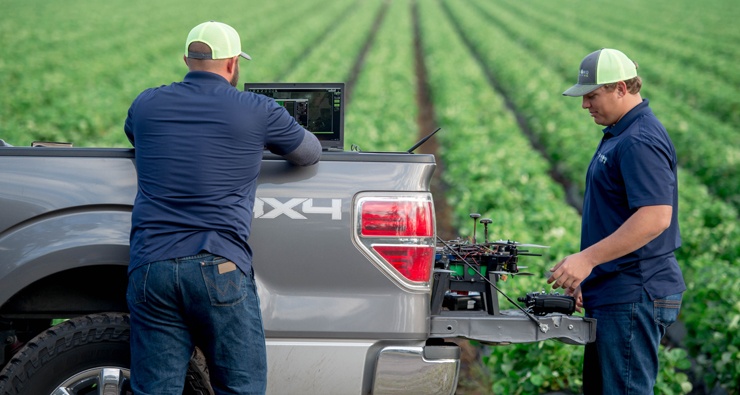On Monday, August 29, the Federal Aviation Administration’s (FAA) new rules for commercially used, small unmanned aerial systems (sUAS) went into effect.
LEARN MORE ABOUT HIGHLAND’S IMAGERY AND ANALYSIS SERVICES.
In the past, sUAS operators needed a pilot’s license to fly a drone for commercial purposes. Now, individuals over the age of 16 can take a test at an FAA-approved facility to receive a remote pilot certificate. Applications must also pass a background check.
RESTRICTIONS TO NOTE
Named Part 107, the new regulations make it easier to gain the certification needed to operate a drone for commercial use. However, there are still several restrictions to take note of:
- Drone must stay within the visual line of sight of the operator.
- Daylight-only operations, or civil twilight (30 minutes before official sunrise to 30 minutes after official sunset, local time) with appropriate anti-collision lighting.
- May not operate sUAS over any persons not directly participating in the operation, not under a covered structure, and not inside a covered stationary vehicle.
- Cannot go higher than 400 feet above the ground.
- Maximum speed is 100 mph.
HOW THEY APPLY TO YOU AND YOUR FARM
Anthony Machado, Highland’s Director of Operations, has more on the new rules and how they apply to growers currently using drone technology:

WHY ALL THE RULES AND REGULATIONS? CAN’T DRONES BE CONTROLLED TECHNOLOGICALLY?
Even with all the technology today in the area of small UASs, there is still the human factor. This is where the rules and regulations play a vital role in safety. The FAA’s main concern with all the areas it governs is the safety of those participating in the operation, or those affected by the operation of small UASs.
Even with the endless safety features built in to many of the flight controllers in today’s small UASs, there is still a human holding a controller. This has many positives and some negatives. While we all know from experience that electronics can malfunction, the human control factor allows for a properly trained and certified operator to keep the participants and non-participants safe in those instances.
On the same notion, a sUAS operator without the proper training and certification can be a danger to themselves, participants and non-participants. The key in all commercial operation is to breed a culture of safety and understanding of the needs for rules and regulations. With the new rules, the FAA is realizing the potential for positive effects of small UASs in multiple commercial applications without over burdening the company or users with complicated licensing and regulations.
HOW DOES THIS CERTIFICATION COMPARE TO HAVING A PILOT’S LICENSE?
The new rules require all sUAS operators to complete and pass an aeronautical knowledge test. This test is similar to the test a pilot takes, but is geared more towards the uses of the small UAS, as opposed to a plane. Unlike a pilot, however, sUAS operators are not required to complete flight hours and medical certifications.
Small UAS operators must also be vetted by the TSA. The individual’s test score and TSA information is then submitted to the FAA for review.
The certification is good for 24 months, at which time the operator must retest. This keeps the operators up to date with any new rules and regulations.

WHAT DO I DO IF I NEED TO OPERATE MY DRONE OUTSIDE OF THE RESTRICTIONS? FOR EXAMPLE, WHAT IF I NEED TO FLY IT OUT OF MY LINE OF SIGHT?
While there is the possibility to apply for waivers to certain restrictions, it is not a guarantee that it will be approved. Operating within line of sight is a key safety and operating restriction that all sUAS Operators must adhere to.
I do not foresee the FAA granting a waiver to such a restriction with the current technologies available. Some possible waiver areas include operating from a moving vehicle, operating over non-participants, operating multiple small UASs, etc.
I’M ALREADY USING DRONES ON MY FARM. WHERE CAN I GET THE NEW CERTIFICATION?
The FAA website offers plenty of information on the certification process of sUAS Operators.
On the website, you can find your nearest FAA-approved Airman Knowledge Testing Center. The test comes at a price of $150.
Study material is available on the site, along with the steps that need to be completed after the test. For example, being vetted by the TSA and submitting your scores for review and certification all occur after taking the initial exam.
FUTURE INITIATIVES
For agricultural business owners, the new rules make it easier to train up-and-coming growers. But farmers with large fields may be disadvantaged by some of the more specific restrictions.
The FAA has struggled to create rules on commercial sUAS use. While the newly established rules are a step in the right direction, more rules and regulations are likely to be created in the future.
To spearhead integrating drones into the national airspace, the FAA has created and staffed two senior-level offices. These offices will head an industry-wide advisory committee that will begin the process of creating, implementing and enforcing new policies.
Sources:
Los Angeles Times
The Wall Street Journal